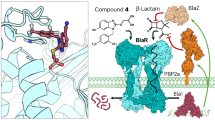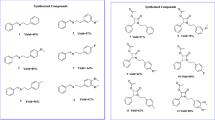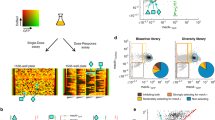Abstract
Natural lipopeptide antibiotic tripropeptin C (TPPC) revitalizes and synergistically potentiates the activities of the class of β-lactam antibiotics against methicillin-resistant Staphylococcus aureus (MRSA) but not against methicillin-sensitive S. aureus in vitro; however, the mode of action remains unclear. In the course of the study to reveal its mode of action, we found that TPPC inhibited the β-lactamase production induced by cefotiam. This prompted us to focus on the β-lactam-inducible β-lactam-resistant genes blaZ (β-lactamase) and mecA (foreign penicillin-binding protein), as they are mutually regulated by the blaZ/I/R1 and mecA/I/R1 systems. Quantitative reverse-transcription polymerase chain reaction analysis revealed that TPPC reversed β-lactam resistance by reducing the expression of the genes blaZ and mecA, when treated alone or in combination with β-lactam antibiotics. In a mouse/MRSA septicemia model, subcutaneous injection of a combination of TPPC and ceftizoxime demonstrated synergistic therapeutic efficacy compared with each drug alone. These observations strongly suggested that reverse β-lactam resistance by TPPC may be a potentially effective new therapeutic strategy to overcome refractory MRSA infections.
Similar content being viewed by others
Log in or create a free account to read this content
Gain free access to this article, as well as selected content from this journal and more on nature.com
or
References
Boucher, H. W. et al. Bad bugs, no drugs: no ESKAPE! An update from the infectious diseases society of America. Clin. Infect. Dis. 48, 1–12 (2009).
Klevens, R. M. et al. Invasive methicillin-resistant Staphylococcus aureus infections in the United States. J. Am. Assoc. 298, 1763–1771 (2007).
DeLeo, F. R., Otto, M., Kreiswirth, B. N. & Chambers, H. F. Community-associated methicillin-resistant Staphylococcus aureus. Lancet 375, 1557–1568 (2010).
Otter, J. A. & French, G. L. Molecular epidemiology of community-associated methicillin-resistant Staphylococcus aureus in Europe. Lancet Infect. Dis. 10, 227–239 (2010).
Song, M. D., Wachi, M., Doi, M., Ishino, F. & Matsuhashi, M. Evolution of an inducible penicillin-target protein in methicillin-resistant Staphylococcus aureus by gene fusion. FEBS Lett. 221, 167–171 (1987).
Ubukata, K., Nonoguchi, R., Matsuhashi, M. & Konno, M. Expression and inducibility in Staphylococcus aureus of the mecA gene, which encodes a methicillin-resistant S. aureus-specific penicillin-binding protein. J. Bacteriol. 171, 2882–2885 (1989).
Villegas-Estrada, A., Lee, M., Hesek, D., Vakulenko, S. B. & Mobashery, S. Co-opting the cell wall in fighting methicillin-resistant Staphylococcus aureus: potent inhibition of PBP 2a by two anti-MRSA beta-lactam antibiotics. J. Am. Chem. Soc. 130, 9212–9213 (2008).
Novick, R. P. Staphylococcal penicillinase and the new penicillins. Biochem. J. 83, 229–265 (1962).
Franklin, D. L. Antimicrobial resistance: the example of Staphylococcus aureus. J. Clin. Invest. 111, 1265–1273 (2003).
Hiramatsu, K. et al. Methicillin-resistant Staphylococcus aureus clinical strain with reduced vancomycin susceptibility. J. Antimicrob. Chemother. 40, 135–136 (1997).
Holmes, N. E., Johnson, P. D. R. & Howden, B. P. Relationship between vancomycin-resistant Staphylococcus aureus, vancomycin-intermediate S. aureus, high vancomycin MIC, and outcome in serious S. aureus infections. J. Clin. Microbiol. 50, 2548–2552 (2012).
Moravvej, Z. et al. Update on the global number of vancomycin-resistant Staphylococcus aureus (VRSA) strains. Int. J. Antimicrob. Agents 42, 370–371 (2013).
Hashizume, H. et al. Tripropeptins, novel antimicrobial agents produced by Lysobacter sp. I. Taxonomy, isolation and biological activities. J. Antibiot. 54, 1054–1059 (2001).
Hashizume, H. et al. Tripropeptins, novel antimicrobial agents produced by Lysobacter sp. II. Structure elucidation. J. Antibiot. 57, 52–58 (2004).
Hashizume, H. et al. Tripropeptin C blocks the lipid cycle of cell wall biosynthesis by complex formation with undecaprenyl pyrophosphate.Antimicrob. Agents Chemother. 55, 3821–3828 (2011).
Hashizume, H., Takahashi, Y., Harada, S. & Nomoto, A. Combination effect of natural lipopeptide tripropeptin C and clinically important drugs against MRSA and VRE. in 54th Interscience Conference on Antimicrobial Agents Chemotherapy (Washiongton, DC, abstr., Poster F-255, American Society for Microbiology, 2014).
Hashizume, H., Takahashi, Y., Harada, S. & Nomoto, A. Natural lipopeptide antibiotic tripropeptin C revitalizes and synergistically potentiates the activity of beta-lactam against methicillin-resistant Staphylococcus aureus. J. Antibiot. 68, 373–378 (2015).
Moody, J. Synergism testing: broth microdilution checkerboard and broth macrodilution methods. in Clinical Microbiology Procedures Handbook 2nd edn (eds Garcia, L. S. & Isenberg, H. D.) (ASM Press, Washington, DC, 5.12.1–5.12.23, 2007).
O’Callaghan, C. H., Morris, A., Kirby, S. M. & Shingler, A. H. Novel method for detection of beta-lactamases by using a chromogenic cephalosporin substrate. Antimicrob. Agents Chemother. 1, 283–288 (1972).
Gardete, S., Lencastre, H. & Tomasz, A. A link in transcription between the native pbpB and the acquired mecA gene in a strain of Staphylococcus aureus.Microbiology 152, 2549–2558 (2006).
Hou, Z. et al. Co-blockade of mecR1/blaR1 signal pathway to restore antibiotic susceptibility in clinical isolates of methicillin-resistant Staphylococcus aureus. Arch. Med. Sci. 7, 414–422 (2011).
Pietiainen, M. et al. Transcriptome analysis of the responses of Staphylococcus aureus to antimicrobial peptides and characterization of the roles of vraDE and vraSR in antimicrobial resistance. BMC Genomics 10, 429 (2009).
Kawada-Matsuo, M., Yoshida, Y., Nakamura, N. & Komatsuzawa, H. Role of two-component systems in the resistance of Staphylococcus aureus to antibacterial agents. Virulence 2, 427–430 (2011).
Ishizaki, Y. et al. Inhibition of the first step in synthesis of the mycobacterial cell wall core, catalyzed by the GlcNAc-1-phosphate transferase WecA, by the novel caprazamycin derivative CPZEN-45. J. Biol. Chem. 288, 30309–30319 (2013).
Hirosawa, S., Takahashi, Y., Hashizume, H., Miyake, T. & Akamatsu, Y. Synthesis and antibacterial activity of tripropeptin C derivatives modified at the carboxyl groups. J. Antibiot. 67, 265–268 (2014).
Meng, J. et al. Restoration of oxacillin susceptibility in methicillin-resistant Staphylococcus aureus by blocking the MecR1-mediated signaling pathway. J. Chemother. 18, 360–365 (2006).
Meng, J. et al. Reversion of antibiotic resistance by inhibiting mecA in clinical methicillin-resistant Staphylococci by antisense phosphorothioate oligonucleotide. J. Antibiot. 68, 158–164 (2015).
Qin, W., Panunzio, M. & Biondi, S. Beta-lactam antibiotics renaissance. Antibiotics 3, 193–215 (2014).
Acknowledgements
The authors greatly appreciate the valuable advice from Prof Akio Nomoto and Dr Yoshimasa Ishizaki and the technical support from Shigeko Harada and Akiko Harakawa at the Institute of Microbial Chemistry (BIKAKEN, Japan).
This work was supported by the Japan Society for the Promotion of Science KAKENHI, grant numbers 24710254 and 16K08338.
Author information
Authors and Affiliations
Corresponding author
Ethics declarations
Competing interests
The authors declare no conflict of interest.
Additional information
This article is dedicated to Prof. Hamao Umezawa on the occasion of the 60th anniversary of worldwide marketing of kanamycin.
Supplementary Information accompanies the paper on The Journal of Antibiotics website
Supplementary information
Rights and permissions
About this article
Cite this article
Hashizume, H., Takahashi, Y., Masuda, T. et al. In vivo efficacy of β-lactam/tripropeptin C in a mouse septicemia model and the mechanism of reverse β-lactam resistance in methicillin-resistant Staphylococcus aureus mediated by tripropeptin C. J Antibiot 71, 79–85 (2018). https://doi.org/10.1038/ja.2017.88
Received:
Revised:
Accepted:
Published:
Issue date:
DOI: https://doi.org/10.1038/ja.2017.88
This article is cited by
-
Precursor-directed biosynthesis and biological activity of tripropeptin Cpip, a new tripropeptin C analog containing pipecolic acid
The Journal of Antibiotics (2024)
-
Subinhibitory Levels of Fluoroquinolones Result in Enrichment of the Membrane Proteome of Staphylococcus aureus
Journal of Ocean University of China (2023)
-
Lipid oligonucleotides as a new strategy for tackling the antibiotic resistance
Scientific Reports (2020)



